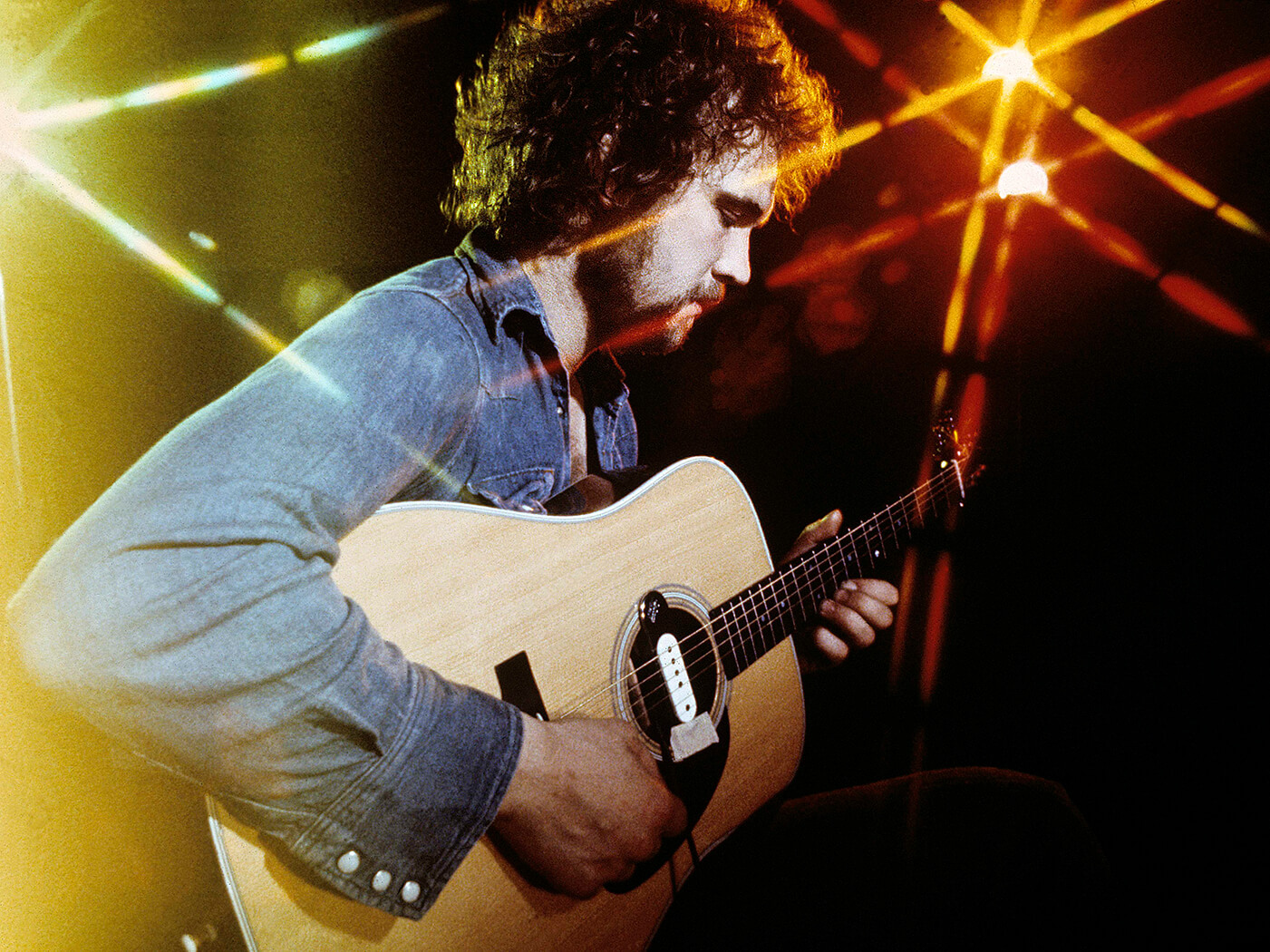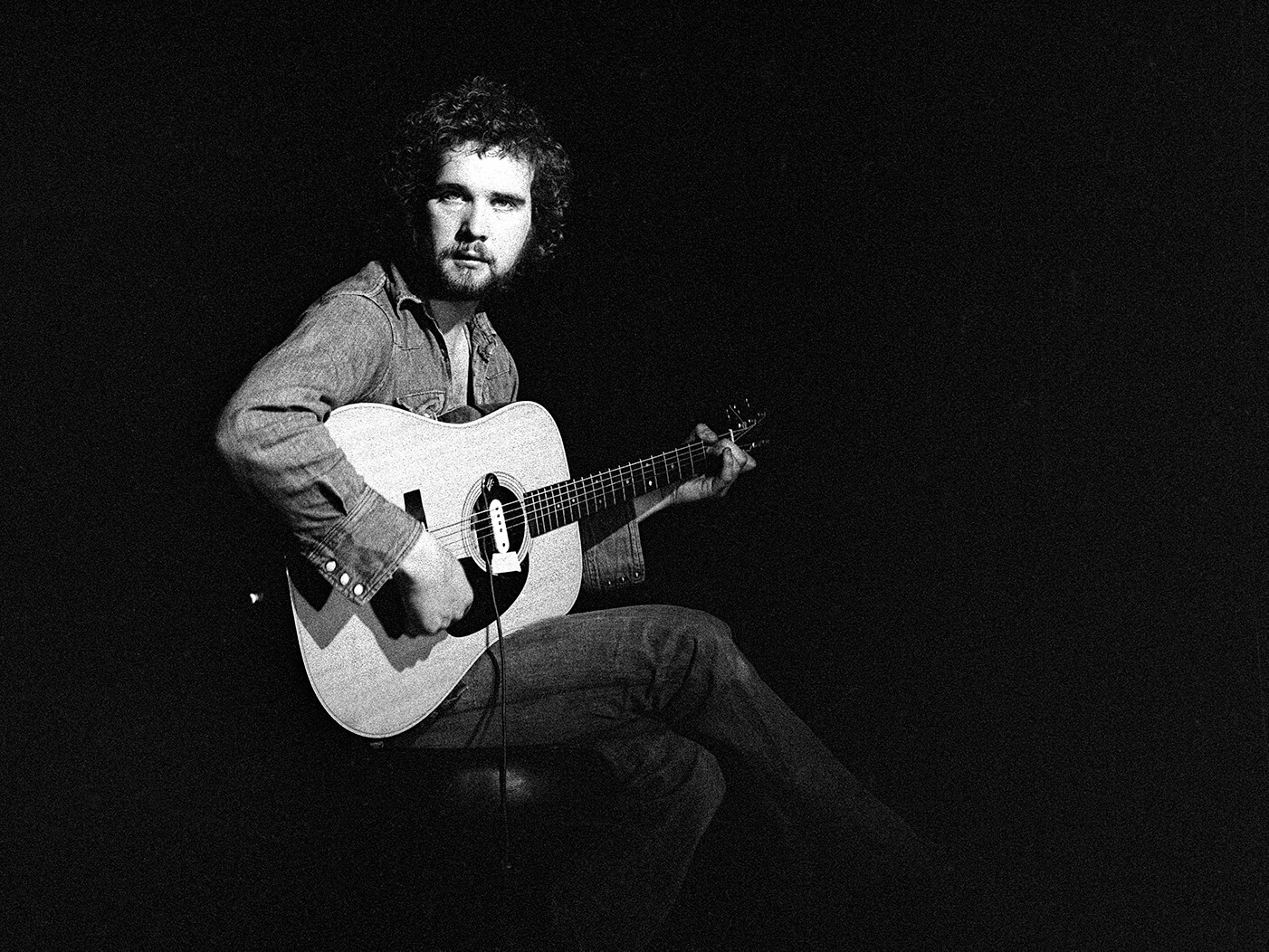John Martyn: “Playing live is a very rewarding thing to do, the nicest way to make money I know”
John Martyn had battled through some serious health difficulties to create a fine album when we caught up with the folk maestro on the comeback trail to talk gear, effects and recently broken guitars in this interview from March 2004.

Martyn’s DeArmond soundhole pickup went to his effects chain; the Barcus Berry contact pickup behind the bridge went to a dry channel. Image: Estate Of Keith Morris / Redferns / Getty Images
This interview was originally published in 2004.
Since he entered the public consciousness with his debut album London Conversation in 1967 (he was the Island label’s first white solo singer), John Martyn has earned not only respect, but a reputation for not suffering fools gladly. So pity the poor interviewer sent to talk to him the day after his beloved ’65 Gibson SG lost its headstock on the stage of London’s Queen Elizabeth Hall.
But the rule with John Martyn is that there are no rules – because, after losing a lower leg in April last year when a bursting cyst led to an amputation below the knee, this is a man so glad to be playing live again, he’s able to see the bright side of just about anything.
“Sadly, the guitar fell to the floor and the headstock broke!” Martyn mock-sobs, then decides to put a gruff Glaswegian gloss on proceedings. “I’d noticed a crack in the headstock before we went on tour and I asked John Giblin, my bass player who deals in guitars, if he could get me another… and last night, that came in very handy.”

The ‘new’ SG, Martyn explains, could prove to be an even better instrument. “It has a nice, fatter neck, though it’s not quite as strong. I think it’s 1970-ish. I’ve had my ’65 since, ooh, about 1969.”
Nevertheless, the beloved original is undergoing repair, and its fate won’t persuade its owner to lock such valuable vintage guitars away. “No, no, they’ve got to be used,” he insists. “No point having them, otherwise.”
Significantly, in view of his recent trials, the sole song from new album On The Cobbles he chose to showcase on his recent UK tour is My Creator. Has John Martyn gone religious on us? It seems to be the case… “Not to be too holy about it, but it is a bit like a prayer,” Martyn says. “That tune is going to be with me for years. I intend to rewrite it almost every night, if you know what I mean. It’s improvising – very simple. It’s the chance I had to write a horn line and I’m very proud of it. I intend to do a lot more of that!”
Personal effects
Interestingly, the use of effects that has now become one of John Martyn’s many sonic trademarks was originally done with the intention of making his guitar sound more like a horn. “Yeah, I wanted the sustain a horn gets,” he confirms, “and I managed it – in a way. Not as soulfully as a horn; you can’t beat a lovely horn! But the Echoplex and the rhythmic stuff do sound good.”
You’d assume that these days, he’d use a multi-FX or a Pod, but he cheerfully admits he totes around “much the same gear as I used to, to be honest”. He’s been known to do running repairs with a screwdriver while talking to his audience, though maybe those days are gone now – as, indeed, is his beloved Echoplex, stolen in Liverpool four years ago.
“Since then, I’ve been using an Alesis, which is very good. But there’s a lot of compression on it, so it tends to hiss a lot, and there’s a trigger at the top, which is a nuisance,” he says. “But the guy who developed the Echoplex is supposed to be putting it back on the market; I’m in touch with him, and I’m looking forward to using it.”
The new album sees the mysterious ‘Mutron guitar’ credited on several tracks. “They’re now called Q-Trons,” Martyn explains (different company, though: he uses an Electro-Harmonix Q-Tron+).

“It’s an automatic wah-wah that goes through five or six octaves. I like it because it’s very ‘muddly’ and I’ve always liked using a tonic rather than a straight third or a fifth as what I call a ‘hanger’ – a suspended chord running all the way through the tune. You don’t hear it… in fact, it just adds body. It’s subliminal. If you put some fuzz on it, turn it down to a very low level and scrub away like an old lady with a nailbrush, it ends up forming a blanket effect, which I like. Instead of hanging there going ‘oooo-ooo’ it can go ‘oooo-eee-oh’… if that makes any sense!” he chortles. “You can play one chord, fiddle around and make it moveable.”
There’s a trade secret or two mixed in there among the techno-babble – but if would-be Martyns want to learn how he does it, he has nothing to hide. “I’ll tell anybody anything! I used to follow people around. I didn’t ask, I used to sit at the front and watch – it’s the best way to learn. The best way to figure out how to do things is watch the fingers. I watched all kinds of people! Not rock ’n’ roll, though, it was all folk for me. Davy Graham was my hero and still is. Hamish Imlach is a very underrated guitarist with a very strange style, a cross between flamenco and blues. His right hand was like a bee’s wing. Very cool player.”
Martyn’s Martins
Talk turns to when he started using different tunings: “I was about 17… so subtract 17 from 55,” he laughs. In concert, Martyn will limit himself to a handful: “I don’t use as many tunings as I used to,” he confirms. “I used three last night – DADGAD, C and straight tuning. I normally use a fiddle tuning on the electric and I use that all the way through the set. It’s all in fifths instead of thirds. In America they call it cello tuning.”
His acoustic-guitar playing is arguably better known than his electric – so is he rock, folk or what? “I love playing guitar of any type,” he says. “There’s a different context for both sorts – it’s whatever fills the bill.”
The two acoustics he takes on tour are both Martins, and were gifts from the company. “One’s a D-28 and one’s a C something, I can’t remember. The D-28 is particularly lovely, ’cos it’s got Maltese crosses all over it, and on the bridge it has inlays of mother of pearl. It’s a lovely guitar, sounds nice and sweet.”

John Martyn has never run away from a challenge… well, maybe just the one. The Verve, when in their chart-topping pomp, asked John to open their homecoming show in the grounds of Wigan’s Haigh Hall in 1998. He’d been booked to play with his own band, but an administrative mix-up led to him taking the stage unrehearsed and without having had a soundcheck, accompanied by only an acoustic and percussionist Arran Ahmun. To cap it all, his guitar strap broke – but despite adversity and 32,000 Verve fans who’d probably never heard of him, so full was the sound the duo made that a member of support act Beck’s entourage dashed round to find out “who the band was on stage!”
John’s memories of the event are less happy. “It was awful!” he cringes. “The age gap was just ridiculous, so I scuttled off stage after 20 minutes; the Verve audience had a totally different mindset to me.” (To show there’s no hard feelings, the band’s ex-lead guitarist Nick McCabe appears on the new album.)
John’s next challenge is to play gigs standing up. “I sit at the moment, but that’s going to stop. I tried the first five or six standing, but it was too painful, it disturbed my concentration. But it’s early days: they say it takes two years for a prosthesis to settle down and I’ve only had mine for three, four, five months.”
Anyone hoping to hear more of On The Cobbles live may have a wait – not because the man’s retiring, but because he’s used his time off the boards to write material for another album. But live performance remains his lifeblood. “I couldn’t wait to get back to it, for sure. It’s a very rewarding thing to do, the nicest way to make money I know. It’s what I live for, it’s my business.”
The gig at London’s QEH where a besotted female fan presented him with a floral bouquet (not a dry eye in the house) was clearly a success for both audience and performer. But what of the nights when it doesn’t go so well? John admits he’s had a few of those… “You can go on and play your balls off, the best thing you’ve done for a month, and the audience remain indifferent for some reason. Then you can play a mediocre set and they go potty. It’s strange.” He warms to his theme. “Gigs should be graded! Out of 10 gigs, seven should be really fucking good, one’s allowed to be a disaster and two should be really shining, that’s what I think. Two should be fucking outstanding and you’re allowed to have one bummer.”
If you know just one John Martyn song, it’s probably May You Never, subject of cover versions from everyone from Eric Clapton to, most recently, Judie Tzuke. Clichéd as it may seem, the valediction ‘may you never stop playing’ seemed an appropriate way to end our London conversation with John Martyn. “I wouldn’t consider it,” comes the immediate answer. And in the end, what’s a broken guitar between friends?
For more interviews with guitar greats, click here.
